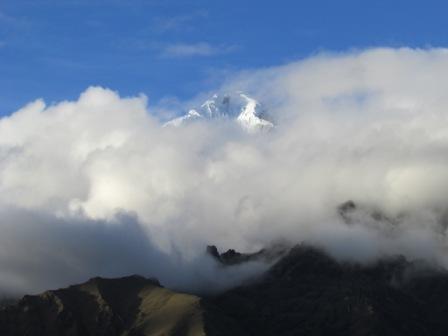The Inca Trail
 A view of Montana Veronica
A view of Montana Veronica
It’s pretty cool to see so many tourists to Peru wear hiking boots. Reminds me of Aspen where everyone arrives with ski gear. It’s healthy. In Peru, the number one tourist attraction is Machu Picchu. Many who go there hike 30 miles to do so, trekking as high as 14,000 feet in the process. The air’s thin; we see a man taking oxygen at our Cusco hotel.
The Inca Trail is really a system of trails, some 18,000 miles of trails that criss-cross the Inca Empire. Hanging bridges spanning rushing rivers were originally made of vegetable fibers. The trails are known for their rock steps, carved into the sides of steep cliffs and mountain-sides. A 66-foot tunnel was cut through solid rock before modern tools were available.
A two-hour drive from Cusco to trail head. We do a three-day trek on a lower elevation section of the trail. This is tough hiking but luxury hiking. We have a guide, and a chef and an assistant chef and a waiter! They double as porters. Our tents are set, meals on the trail are three-course and gourmet. Even “special tent” is set and removed with mobile toilet.
We begin at Ollantaytambo, cross the river and gradually rise. Our hearts pound as we gasp for air, and suck water from our Camelbacks as we hike high above the valley floor. A bird’s eye view of fields of green below. Trains whistle as they pass through towns without railroad crossing signals. Three private rail lines now serve Machu Picchu on a single track. We pass through a tiny settlement and back up quickly as an ox threatens our path. Views of the 19,100 foot Montana Veronica stun us.
We reach our camp site. The porters have already set up our tents and a meal is ready. A local boy easily guides us up a thousand feet up the mountain to an Inca quarry, hands in pockets throughout. Small shrines on top of boulders honor workers killed by boulders crashing down from above. Our guide Disnarda gives treats to young boys we meet on the trail, a nice break from their chore of checking on their cows and livestock.
After dinner we tuck into our North Face and Kelty bags.
Day Two: We follow the muddy Urubamba River, passing through ancient communities, walking by cemeteries. We learn of the Day of the Dead, November 14th each year, when families honor their ancestry with offerings, even singing and dancing at the grave sites. Sounds like a good party. We snack on passion fruit and nuts.
Along the way we see young men harvesting maize manually, loading a large truck that will take their produce to Lima. We pass massive Blue Agave, and forests of Eucalyptus. A giant pig is resting on the trail, sound asleep. We pass locals who use the trail as their primary form of transportation. And we always hear the rushing of the Urubamba. The camp site features a sauna; the rain cools us afterwards.
